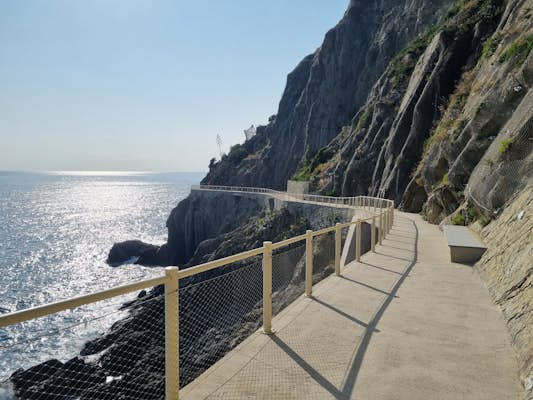Trekking Guide: 10 Amazing Steps to Prepare for Your First Trek in 2023
Are you looking for a trekking guide to help you with your first trek? If yes, then you have come to the right place! When I went for my first trek, I didn’t really know what I am getting myself into. I thought it would be like walking on rolling hills and frankly, easy as […]
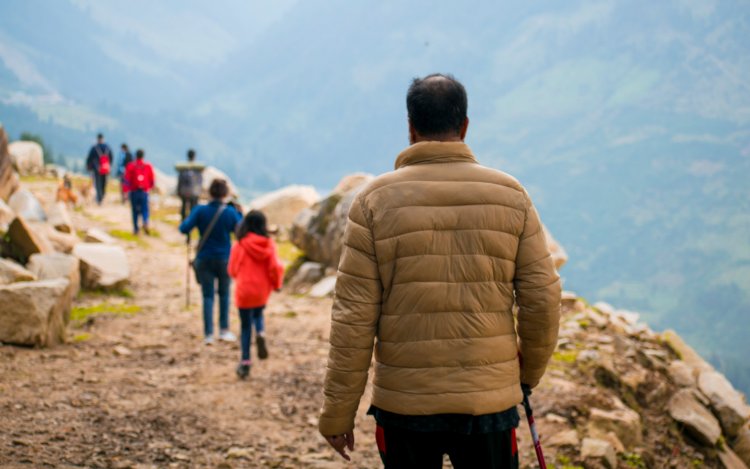
Are you looking for a trekking guide to help you with your first trek? If yes, then you have come to the right place!
When I went for my first trek, I didn’t really know what I am getting myself into. I thought it would be like walking on rolling hills and frankly, easy as hell. But what I didn’t anticipate was the muddy trails, climbing on the rocks and soil, walking on narrow trails, and almost slipping numerous times from the edge.
My first trek was to Kheerganga and it was a downright mess, I didn’t have proper shoes or trekking equipment with me and I didn’t research properly before commencing this trek.
As a result, I faced a lot of problems and as an acrophobic, it was really scary for me. And frankly, it put me off trekking for a while too but after some time, I started preparing for it and well, the view at the end of the trek is definitely worth the effort. But this doesn’t have to be the case with you.
If you love adventures then you will definitely love trekking, all you need to do is prepare well for your first trek and you are good to go. In this trekking guide, I will be clearing a few basics about trekking and how you can prepare yourself for your first trek.
Trekking Guide: 10 Amazing Steps to Prepare for Your First Trek in 2023
What is Trekking?
Trekking is an outdoor recreational activity in which you hike or walk for multiple days at a time.
A lot of people often confuse hiking and trekking but in reality, both of these activities are quite different from each other. Hiking means walking on a defined trail in a natural environment which usually lasts anywhere between 2 to 8 hours.
A hike doesn’t require a lot of planning and can often be completed with the help of a daypack.
On the other hand, trekking can be performed on all kinds of terrains and might not have proper trails to help you on your way.
An elaborate trek may cover roads, mountains, and some unmarked places as well. And this kind of trek can last anywhere between a day or a month or more.
For trekking, you need to be properly prepared and should have adequate equipment if you don’t want to end up getting hurt on the trek. And this is also a good way to check your physical and mental fitness.
So, it is safe to say that trekking is a high-intensity activity that can be challenging and requires proper skills and gear to complete it.
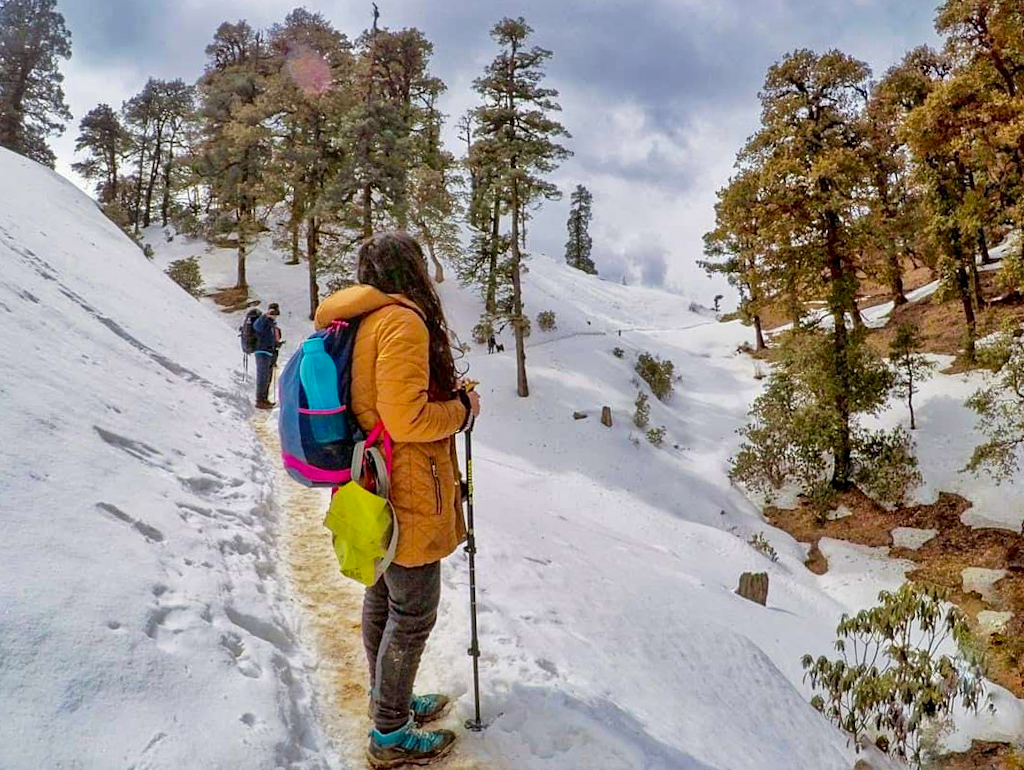
How to Plan For Your First Trek
Follow the below mentioned steps to prepare for your first trek and have an amazing experience. Step 1: Choose an Easy and Comfortable Trek for Your First Time
The first step would be to choose an appropriate trek for your first time. For this, you would need to see the difficulty level of the trek to choose the one that suits you. Based on difficulty, there are three types of treks in India: easy, moderate, and difficult.
An easy trek takes a couple of days to be completed and is usually on easy terrain. There aren’t too many highs and lows on the trek and one usually walks 5-6 km in a day to complete it.
A few examples of easy treks would be the Naag Tibba Trek, Dayara Bugyal Trek, and so on.
A moderate trek requires a bit of stamina and walking 5-6 hours in a day on various terrains and can be slightly challenging. Hampta Pass Trek, Brahmatal Trek, Har Ki Dun Trek, etc. are a few examples of moderately difficult treks.
And finally, a difficult trek requires walking long hours through steep inclines and rough terrains. It can often lead to ascending to an altitude of 14,000 ft. and can stretch to a week or two. The Everest Base Camp trek is one example of a high-difficulty trek.
So, for your first trek, you have to choose an easy gradient trek to get an idea of what to expect. Once you are comfortable, you can go for a moderate or a difficult trek. Step 2: Research About the Trek Terrain Extensively
Once you have chosen your trek, you need to do proper research on it in order to prepare for it. Read blogs on the trek and learn how different people felt about this trek. Check the weather conditions and ask some locals about the present conditions of the trek.
Once you have gathered enough information on the trekking terrain, you can start planning the trek and start your own fitness routine for it. Step 3: Choose a Good and Certified Trekking Company
Once you have chosen your trek and learned more about the terrain and the trek trail, it is time to choose a good trekking company for yourself.
Although a lot of people do treks without a guide or a trekking group, it is always a good idea to do your first trek with an experienced group, especially if you are trekking alone.
This will help you get a feel of the trekking adventure and ensure your safety at the same time. And the best part is that you don’t have to worry about most of the basics like stay, food, etc.
So, make sure that you compare the reviews for a few trekking companies and guides before choosing one for yourself. There are many good companies like Indiahikes, Bikat Adventures, Adventurenation, etc. for you to consider from. Step 4: Start Preparing Yourself Physically a Month Before
An important step in preparing yourself for your first trek is to start your physical training a month before your trek. This doesn’t mean you have to go to a gym or do hardcore exercises but simple walking and jogging exercises will work too.
Make sure that you walk at least 10 km a day or jog 7-8 km a day to build your physical strength. Step 5: Get the Right Footwear for Your Trek
You also need to buy a good pair of trekking shoes for yourself and break them in before the trek. Make sure that you go for a good branded pair of trekking shoes and always test them before buying them.
Also, opt for waterproof trekking shoes as they would keep your feet warm and dry in snow and rain which can make a huge difference when you are trekking.
Once you have the right trekking shoes for yourself, start walking and jogging in them to break them so that they will be perfectly comfortable by the time of your trek. Step 6: Build Your Stamina and Leg Strength
Once you are comfortable walking long distances, it is time to focus on your leg strength and build up your stamina. For this, you need to do lunges, squats, cycling, etc. so that your legs are in great shape by the time your trek date arrives.
If you are into sports then daily swimming, football, etc. practice works well too. Step 7: Practice Walking with a Backpack
Apart from building your stamina and leg strength, you also need to be comfortable walking with a heavy backpack on the trek.
Start with a daypack and then gradually move on to the rucksack that you will be carrying with you on the trek. This will make you adjust to the weight and will help you walk faster with a weight on your back too. Step 8: Pack your Backpack Properly
Once you have trained and feel that you are prepared, it is time that you pack your backpack and get ready for the big day.
One thing to keep in mind is that you need to pack light and don’t overload stuff in your bag. Keep only the essentials like a couple of clothing, important trekking gear, travel essentials, and some medications.
Make sure that you also pack a First Aid Kit along with your personal medications.
Also, don’t forget to keep travel medications like High Altitude Sickness (Diamox), motion sickness, vomiting, loose motions, constipation, fever, cold, and so on. You won’t find any pharmaceutical store on your trek so, get all the medications beforehand. Step 9: Enjoy a Healthy Diet a Few Days Before the Trek
Another important step to follow in order to prepare for your first trek is that make sure you eat healthily. Don’t eat junk and fill up on more carbs and protein as this would help you greatly during the trek.
Also, pack a lot of fruits for the trek as it will help you stay fit and energized on the way. Step 10: Get a Good Travel Insurance For Your Trek
Finally, make sure that you get good travel insurance for your trek. Remember that accidents can happen anytime and anywhere.
So, if you don’t want to end up paying a lot later or suffer too much when you get hurt then it is always a good idea to get travel insurance that will cover emergency evacuations and medications for you.
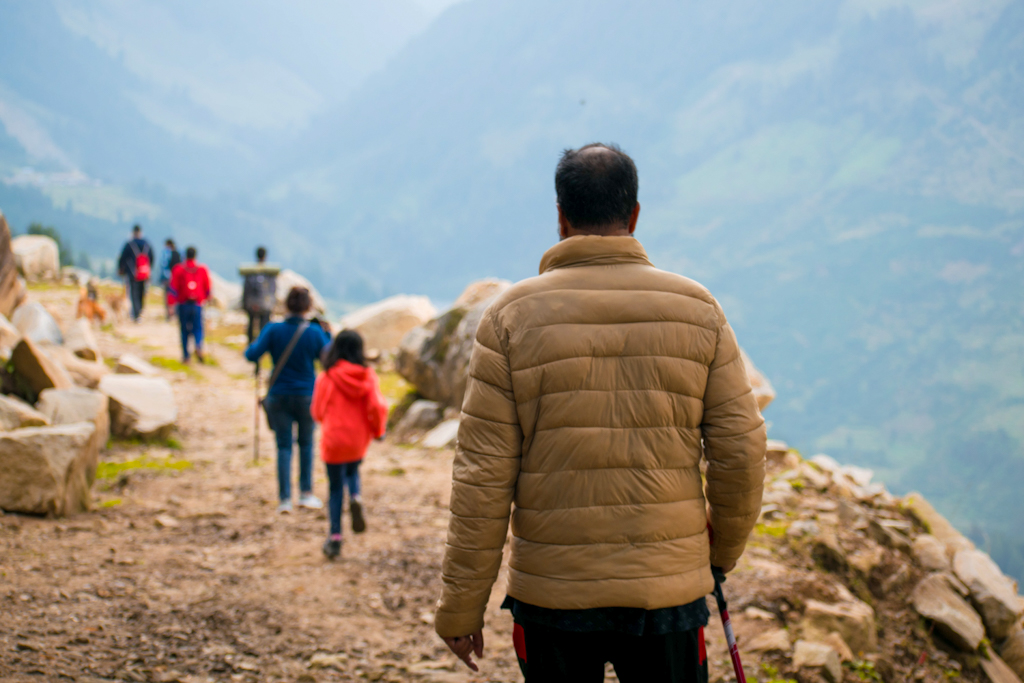
6 Mistakes to Avoid While Trekking For the First Time
Once you are ready and set for your first trek, here are a few strict don’ts to follow if you don’t want to get sick or hurt on the trek. Don’t Wear Sneakers or Sandals on the Trek
One of the biggest mistakes that I made on my first trek was wearing sneakers. And I ended up slipping and tripping the entire time while trekking.
You always need a good pair of sports shoes or trekking shoes for your treks if you want to have a good grip and be comfortable while trekking.
Avoid wearing slippers, sandals, sneakers, etc. as wearing the wrong footwear can be quite dangerous while trekking. Don’t Skip Meals On the Trek
A lot of us often think that stopping for a break and eating something is wasting time or we are worried about upsetting our stomach. But the worse thing to do is to not feed yourself on the trek which can often lead to fatigue and dehydration.
Take small chocolate and energy bars on the trek and eat a good breakfast so that you will stay full for a longer time. Don’t Overestimate Your Physical Fitness
Another major mistake that a lot of trekkers tend to make is to presume they can complete the trek without any physical training.
Yes, you might be a walking or a jogging champ but that cannot equal to trekking, ever. This is because trekking is done on different kinds of terrain and you might have some steep ascends and descends on the way.
So, don’t be overconfident about your stamina and fitness and carefully prepare yourself for the trek. Don’t Pack Your Bag with Unnecessary Items
This is yet another mistake that most first-time trekkers make. We carry everything in our bag, making it bulky and heavy which becomes difficult to carry on the trek.
So, make sure that you only pack essentials and leave behind all the extra items that you won’t be needing. Trust me, this can save you a lot of energy on the trek and will make sure you complete it much faster as well. Learn About the Trek and the Path Before Starting
Another mistake to avoid is going on a trek without having any proper knowledge about the terrain or the route. Because unless you know about the trek, you won’t know how to pack and what to pack for it.
Don’t be lazy and research properly before heading on a trekking adventure. Don’t Go Broke into Trekking
One of the biggest mistakes that you can make is to carry no cash with you while going on a trek.
This can be a huge blunder because more often than not, trek starting points don’t have an ATM so there is no way to take out some cash. And most of the local shops deal in cash only so you would end up being broke on your trek.
So, always carry a sufficient amount of cash before leaving your home.
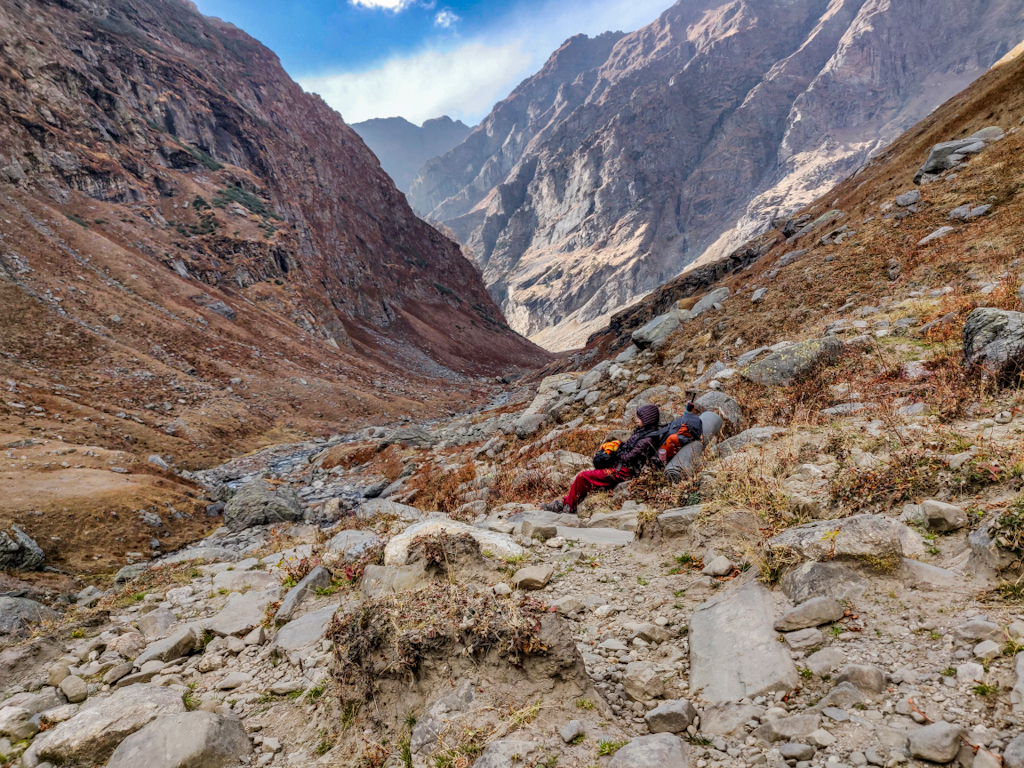
Tips for Successfully Completing Your First Trek
Trekking is not everyone’s cup of tea but it is not impossible if you put your mind to it. You just need to prepare well and be careful on the trek and you would end up having one of the most amazing experiences in your life.
So, here are a few tips for your first trek that can make it easier and more fun for you.
- Make sure that you have a good idea about what you are getting yourself into and don’t do your first trek alone. Get some friends together or join a trekking group but don’t do it alone. You are new to this and might need help on your first trek and if you are alone then there are more chances of you getting lost or hurt on the way.
- Keep a 2 ltr bottle with you and drink up at regular intervals. You might feel that you aren’t thirsty but trekking will leave you dehydrated faster so it is always good to drink, regardless of the fact if you feel thirsty or not.
- Keep a few energy drinks and energy bars to drink and eat on your trek. There are many treks where you won’t come across a single food stall or drink stall so it is good to take your own snacks and food. This way you won’t feel tired or hungry and will be able to complete large stretches in a single day.
- Always keep yourself surrounded by people and don’t stall behind too much because many trekking trails are dangerous and full of wild animals. So, always stay near the guide or a few people to be safe.
- Don’t force yourself beyond your physical capabilities. This means that you don’t have to run to catch up with other trekkers who walk fast, just go at your own pace. If you know that you are a slow trekker then start before your group so that you won’t be left behind but take breaks and walk at a pace that is comfortable for you. There is no hurry to finish the trek.
- Start your treks early in the morning so that you can reach your camp well before night and also have some buffer time with you.
- Finally, enjoy yourself and don’t think about how hard it is going to be or if you would be able to finish the trek. Take one step at a time and enjoy your surroundings and you will be at the summit in no time. And that feeling, of finally getting to the summit is just too amazing to be passed.
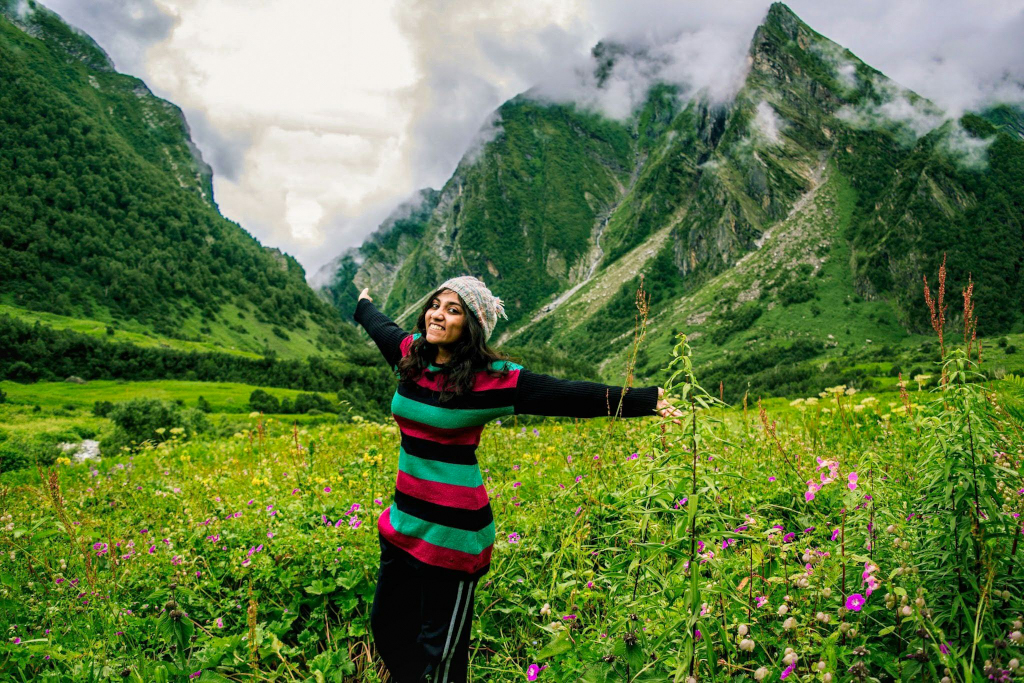
Summary
Well, that’s all. I hope this trekking guide helps you plan an amazing trek and makes you fall in love with this outdoor activity. Remember, your safety is of utmost importance on a trek so avoid doing anything that might jeopardize it.



